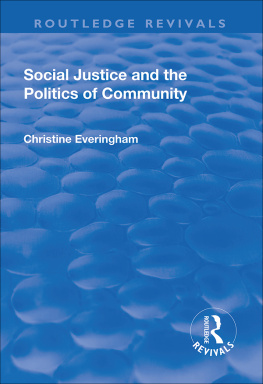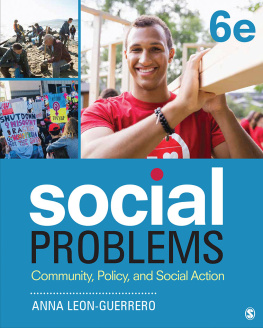COMMUNITY GROUPS IN CONTEXT
Local activities and actions
Edited by Angus McCabe and Jenny Phillimore
First published in Great Britain in 2017 by
Policy Press University of Bristol 1-9 Old Park Hill Bristol BS2 8BB UK Tel +44 (0)117 954 5940 e-mail
North American office: Policy Press c/o The University of Chicago Press 1427 East 60th Street Chicago, IL 60637, USA t: +1 773 702 7700 f: +1 773-702-9756
Policy Press 2017
British Library Cataloguing in Publication Data
A catalogue record for this book is available from the British Library
Library of Congress Cataloging-in-Publication Data
A catalog record for this book has been requested
ISBN 978-1-4473-2777-6 hardcover
ISBN 978-1-4473-2781-3 ePub
ISBN 978-1-4473-2782-0 Kindle
ISBN 978-1-4473-2779-0 ePDF
The right of Angus McCabe and Jenny Phillimore to be identified as editors of this work has been asserted by them in accordance with the Copyright, Designs and Patents Act 1988.
All rights reserved: no part of this publication may be reproduced, stored in a retrieval system, or transmitted in any form or by any means, electronic, mechanical, photocopying, recording, or otherwise without the prior permission of Policy Press.
The statements and opinions contained within this publication are solely those of the editors and contributors and not of the University of Bristol or Policy Press. The University of Bristol and Policy Press disclaim responsibility for any injury to persons or property resulting from any material published in this publication.
Policy Press works to counter discrimination on grounds of gender, race, disability, age and sexuality.
Cover design by Qube Design Associates, Bristol
Front cover image: istock
Readers Guide
This book has been optimised for PDA.
Tables may have been presented to accommodate this devices limitations.
Image presentation is limited by this devices limitations.
List of tables and figures
Tables
Figures
Foreword
Voluntary action is embedded in the culture and communities of the UK. From helping neighbours and running play groups, to planting and nurturing local green spaces and helping our biggest national charities, voluntary work and voluntarism forms the web and weft of our society.
The Charity Commission records show that there are over 160,000 registered charities in the UK. But of course this is only part of the picture. Registered charities are dwarfed by the sheer volume of small informal groups whose members come together on a voluntary basis to carry out charitable activities day in and day out, every week of the year. Those informal groups are found in all communities and at all levels of society they are certainly in every village and town, probably in every street and housing estate. They bring together old and young, men and women, those of every faith, colour and creed, in joint efforts to solve social problems and improve the lives of individuals, communities, themselves and others.
Despite being such an important part of our daily lives, these below the radar groups were under-researched prior to the foundation of the Third Sector Research Centre (TSRC) in 2008. Over the ensuing years, the team has produced a set of research papers that help shine a light on the variety and richness of smaller community organisations.
The range and scope of these organisations is hinted at in an early paper from the TSRC, in which micro-organisations were painstakingly mapped, door to door: in just 11 English streets, an astonishing 58 micro-organisations were found to be alive and well, and the researchers concluded that this is likely to be a substantial underestimate of activity. In subsequent papers, TSRC looked both wide for example, at the impact of austerity on below the radar groups and deep, investigating less well understood corners of the voluntary sector such as those of the Gypsy, Roma and Traveller communities.
This book sets out a body of evidence about this vital aspect of our society and culture. It is a work to be welcomed by academics, community workers, sociologists, policymakers and all those with an interest in the wellbeing of communities in the UK today.
Sara Llewellin
Chief Executive
Barrow Cadbury Trust
Series editors foreword
Third sector scholarship has often been criticised for a focus on highly-visible, quantifiable, and mappable elements of the organisational universe, such as the distribution of voluntary organisations, or levels of formal volunteering through those organisations. Yet over forty years ago scholars were warning of the regressive consequences of such approaches. Cartographic and scientific metaphors pervade the critiques of David Horton Smith and others, with their emphasis on lost continents, dark matter and so forth. It is crucial that a series such as this one does not have a focus solely on formalised and regulated third sector activities and Angus McCabe and Jenny Phillimores edited collection on Community groups in context gives expression to that aspiration. It draws on extensive work in the Third Sector Research Centre both by the Centres research staff and by its associates.
Although there are discussions of the challenges of definition and measurement in this field, the authors would agree that objective representation and cartographic exactitude are impossibilities in this area. Panoptical attempts at quantification have been attempted on numerous occasions, with variable results, and often for cathartic rather than academic reasons. It is to be hoped that serious funders dont continue to pour resources into such exercises at least if they believe that the aim is to arrive at an authoritative estimate of the scale of community-led, grassroots activity. They wont find it or, more accurately, they wont find any agreed estimate. They will certainly find, however, a kaleidoscope of initiative which raises many important questions about the nature of the third sector.
This book will appeal to those engaged in or having a stake in grassroots community activities (for example funders, academics, policymakers, practitioners and activists) for four key reasons.
Firstly, it offers unique insights into the identity of grassroots community organisations: what it is that makes them distinctive, enables them to provide a voice that is authentic and recognised as legitimate?
Secondly, a classic theoretical rationale for third sector activity is the identification and meeting of social needs whether these be those of minority groups who lack leverage through the democratic process, or emerging issues as yet unacknowledged through formal welfare structures. Without descending into an instrumentalist, policy-oriented search, in which below-radar groups are trawled for signs of emerging social enterprises, as in the recent efforts of some thinktanks, this book offers important studies of innovation, through investigating how grassroots groups respond to the needs of small but distinctive communities.
Thirdly, there are concerns about independence, as with almost all parts of the third sector: how do groups which began life urgently articulating the needs of excluded groups without fear or favour maintain that position and retain the rootedness in community which gives them strength?
Finally, there is inspiration: the accounts given here are not rose-tinted narratives of heroic individuals who succeed against great odds. Instead they show how below-radar groups develop alternative, progressive visions, and articulate their case even in unpromising, austere times.





